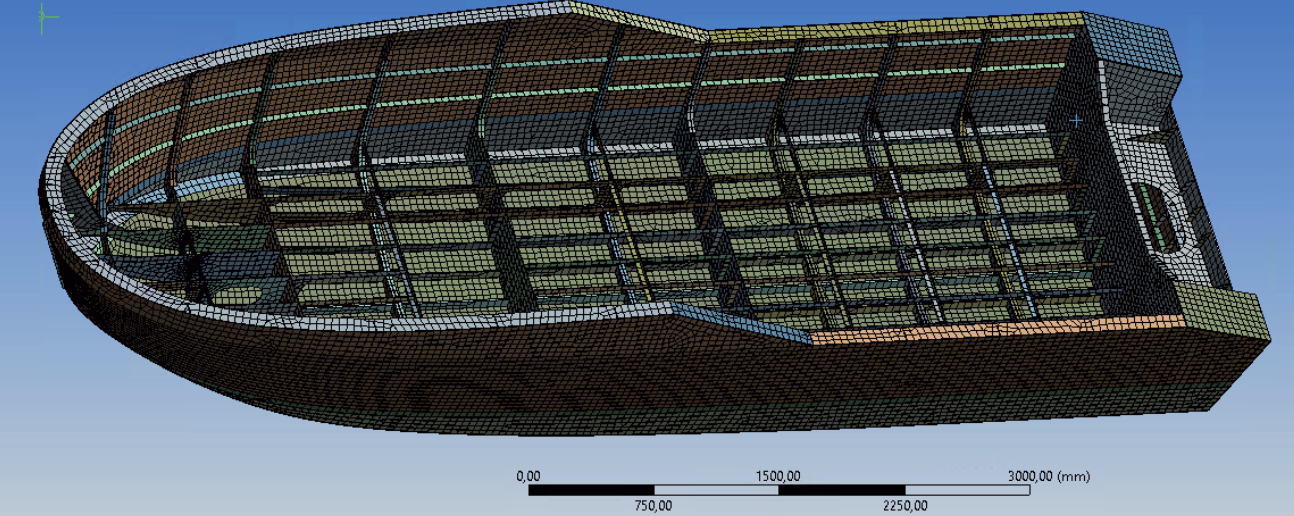Estudio de interacción fluido-estructural por condiciones de transito costero en el arreglo estructural de un bote de combate fluvial de bajo calado
DOI:
https://doi.org/10.25043/19098642.252Palabras clave:
presión Hidrodinámica, análisis directo, cascos en aluminio, interacción fluido –estructuraResumen
Los botes de combate fluvial de bajo calado son embarcaciones fluviales con un arreglo estructural en aluminio exclusivamente diseñado para operar en ríos de baja profundidad. No obstante, debido a la geografía nacional, estas operaciones pudieran extenderse a condiciones de estuario o tránsitos costeros. De esta manera, surge la necesidad de evaluar la resistencia estructural del casco en condiciones de tránsito costero. Para tal fin, se realizó un estudio de interacción fluido estructural en la que se enlaza las presiones hidrodinámicas en el casco como entrada para un análisis por elementos finitos. Las presiones en el casco fueron contrastadas con los valores obtenidos con el uso reglas de las Sociedades de Clasificación.
Descargas
Citas
ALVAR ADO, D. FLORES, E. PAIPA, E.: Design and validation by the method of finite elements for the structure of a low draft combat boat. Ship Science and Technology, vol. 15, nº29, pp. 21-35, (2021). https://doi.org/10.25043/19098642.218
ABS, Rules for building and classing. High-Speed craft. Part 3: Hull Construction and Equipment, Houston, TX. USA: ABS, (2020).
International Organization for Standarization, Small Craft - Hull construction and Scantlings - Part 5: Design pressures for monohulls, design stresses, scantlings determinaion, ISO, (2014).
DET NORSKE VERITAS GERMANISCHER LLOYD ́S DNV-GL, DNV-GL-CG-027- Class Guideline- Finite Element Analysis, (2 015).
YONG, B , WEI- LIANG. J.: Chapter 8: Ship Hull Scantling Design by Analysis. Marine structural design, pp. 171-180, (2016). https://doi.org/10.1016/B978-0-08-099997-5.00009-5
LIU, B., WANG, S. VILLAVICENCIO, R. GUEDES SOARES, C.: Slamming load and hydroelastic structural reponse og bow flare areas of aluminium fast displacement crafts, Ocean Engineering,( 2020). https://doi.org/10.1016/j.oceaneng.2020.108207
COTECMAR. Cálculos de Escantillonado del Bote de Combate Fluvial de Bajo Calado - BCFBC. Cartagena de Indias, (2020). ANYFANTIS, K. «Ultimate strength of stiffened panels subjected to non-uniform thrust,» International Journal of Naval Architecture and Ocean Engineering, vol. 12, pp. 325-342, (2020). https://doi.org/10.1016/j.ijnaoe.2020.03.003
TUPPER, E., Introduction to Naval Architecture, Butterworth-Heinemann, (2015).
LLOYD, A.: Seakeeping: Ship behaviour in rough weater, (1998).
GR ANT. E, METCALFE, A.: Spectral Analysis in Engineering, Butterworth-Heinemann, (1995).
American Bureau of Shipping, Guidance notes on Structural Direct Analysis for High-Speed Craft, Houston: ABS, (2018).
Lloyd ́s Register, Rules for the manufacture, testing and certifications of materials, London: Lloyd's Register Group, (2020).
Lloyd ́s Register, Rules and regulations for the classification of special service craft, London, July (2020).
LIU, B. VILLAVICENCIO, R. SOARES, G.: On the failure criterion of aluminum and steel plates subjected to low-velocity impact by a spherical indenter. International Journal of Mechanical Sciences, vol. 80, pp. 1-15, (2014). https://doi.org/10.1016/j.ijmecsci.2013.12.015
NIEME, E. FRIKLE, W. Y MADDOX, S.: Structural Hot- spot Stress Determination Using Finite Element Analysis. Structural Hot-Spot Stress Approach to Fatigue Analysis of Welded Components, IIW Collection, (2018). https://doi.org/10.1007/978-981-10-5568-3

Descargas
Publicado
Cómo citar
Evento
Sección
Licencia
Derechos de autor 2024 Cotecmar

Esta obra está bajo una licencia internacional Creative Commons Atribución 4.0.
The authors who publish in this Journal certify that:
- The work submitted for publication in The Ship Science and Technology journal, was written by the author, given that its content is the product of his/her direct intellectual contribution.
- All data and references to material already published are duly identified with their respective credits and are included in the bibliographic notes and quotations highlighted as such.
- All materials submitted for publication are completely free of copyrights; consequently, the author accepts responsibility for any lawsuit or claim related with Intellectual Property Rights thereof, Exonerating of responsibility to The Science and Technology for the Development of Naval, Maritime, and Riverine Industry Corporation, COTECMAR.
- In the event that the article is chosen for publication by The Ship Science and Technology journal, the author state that he/she totally transfers reproduction rights of such to The Science and Technology for the Development of Naval, Maritime, and Riverine Industry Corporation, COTECMAR.
- The authors retain the copyright and transfer to COTECMAR the right of publication and reproduction of the work which will be simultaneously subject to the Creative Commons Attribution License (CC - BY), which allows the license to copy, distribute, display and represent the work and to make derivative works as long as it recognizes and cites the work in the manner specified by the author or licensor.
- For more information about the Creative Commons Attribution License (CC -BY) and his use and scope, please visit the following web page https://creativecommons.org/licenses/by-sa/4.0/legalcode








